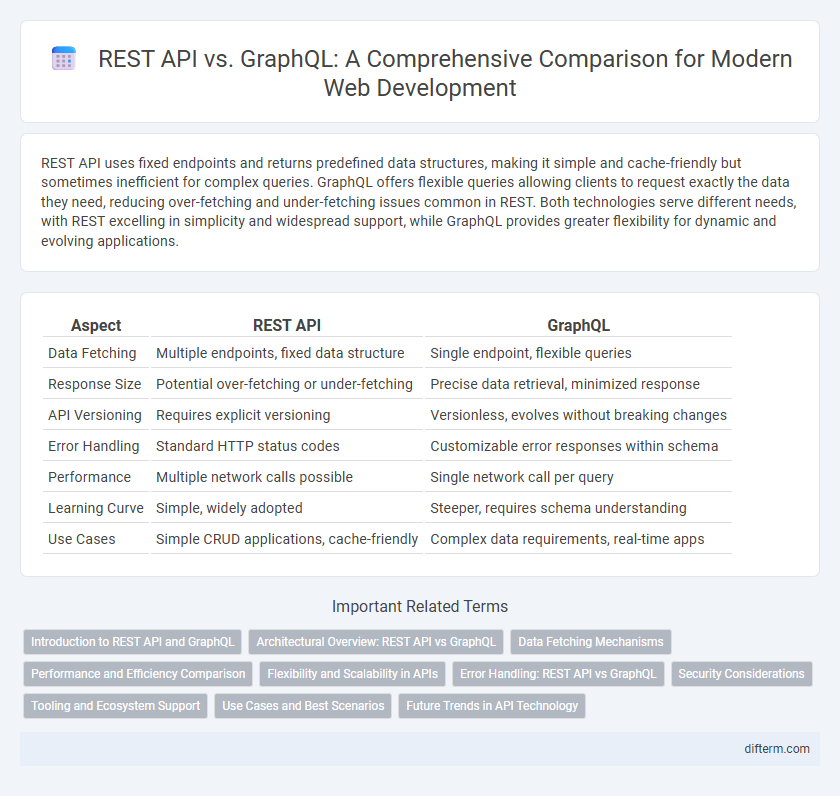REST API uses fixed endpoints and returns predefined data structures, making it simple and cache-friendly but sometimes inefficient for complex queries. GraphQL offers flexible queries allowing clients to request exactly the data they need, reducing over-fetching and under-fetching issues common in REST. Both technologies serve different needs, with REST excelling in simplicity and widespread support, while GraphQL provides greater flexibility for dynamic and evolving applications.
Table of Comparison
| Aspect | REST API | GraphQL |
|---|---|---|
| Data Fetching | Multiple endpoints, fixed data structure | Single endpoint, flexible queries |
| Response Size | Potential over-fetching or under-fetching | Precise data retrieval, minimized response |
| API Versioning | Requires explicit versioning | Versionless, evolves without breaking changes |
| Error Handling | Standard HTTP status codes | Customizable error responses within schema |
| Performance | Multiple network calls possible | Single network call per query |
| Learning Curve | Simple, widely adopted | Steeper, requires schema understanding |
| Use Cases | Simple CRUD applications, cache-friendly | Complex data requirements, real-time apps |
Introduction to REST API and GraphQL
REST API is an architectural style that uses HTTP methods to interact with resources represented as URLs, enabling stateless communication between clients and servers. GraphQL is a query language and runtime designed to load data in a flexible and efficient manner, allowing clients to specify exactly what data they need in a single request. REST API offers simplicity and widespread adoption, while GraphQL provides more precise data retrieval and reduces over-fetching and under-fetching issues.
Architectural Overview: REST API vs GraphQL
REST API employs a stateless, resource-oriented architecture using standard HTTP methods such as GET, POST, PUT, and DELETE to manipulate data through predefined endpoints. GraphQL utilizes a flexible query language allowing clients to request specific data structures, reducing over-fetching and under-fetching issues typical in REST architectures. The architectural shift from fixed endpoints in REST to a single GraphQL endpoint enables more efficient data retrieval and real-time updates via subscriptions.
Data Fetching Mechanisms
REST API uses multiple endpoints for different resources, often requiring multiple round trips to fetch related data, which can lead to over-fetching or under-fetching of information. GraphQL consolidates data fetching into a single endpoint, allowing clients to specify exactly which fields they need, optimizing bandwidth and improving performance. This precise querying reduces the amount of transferred data and enhances flexibility in complex data retrieval scenarios.
Performance and Efficiency Comparison
REST API relies on multiple endpoints leading to over-fetching and slower performance in complex queries, while GraphQL uses a single endpoint allowing clients to request only necessary data, enhancing efficiency. GraphQL reduces network overhead through precise querying, resulting in faster response times compared to REST's fixed data structure. The improved performance of GraphQL is especially evident in mobile and low-bandwidth environments where minimizing data transfer and latency is crucial.
Flexibility and Scalability in APIs
REST API offers a structured approach with fixed endpoints, making it simpler but less flexible in handling diverse client data needs. GraphQL provides enhanced flexibility by allowing clients to specify exact data requirements, reducing over-fetching and under-fetching, which improves performance and scalability. Scalability in GraphQL is supported by its single endpoint architecture and efficient query execution, facilitating optimized resource usage in large-scale applications.
Error Handling: REST API vs GraphQL
REST API error handling relies on standard HTTP status codes to indicate request success or failure, with additional error details often included in the response body. GraphQL consolidates errors within the response's "errors" array, providing granular information while still delivering partial data when possible. This approach enables more precise error resolution and improved client-side handling compared to traditional REST patterns.
Security Considerations
REST API security relies on standard HTTP authentication methods such as OAuth, API keys, and JWT tokens, with strict endpoint access control to prevent unauthorized data exposure. GraphQL introduces unique security challenges due to its flexible query structure, necessitating query complexity analysis, depth limiting, and thorough validation to mitigate risks like Denial of Service (DoS) attacks or data over-fetching. Both REST APIs and GraphQL require robust rate limiting, encryption with HTTPS, and continuous monitoring to ensure data integrity and confidentiality in dynamic client-server interactions.
Tooling and Ecosystem Support
REST API benefits from extensive tooling and a mature ecosystem with widespread support across numerous development environments, including automated documentation tools like Swagger and Postman integration. GraphQL offers advanced tooling for query validation, real-time data subscriptions, and schema introspection, with robust ecosystem support through platforms like Apollo and Relay that simplify client-server interactions. Both technologies are supported by active communities, but GraphQL's modern approach provides more flexibility for evolving APIs and client-driven data requests.
Use Cases and Best Scenarios
REST API excels in scenarios requiring simple, stateless CRUD operations and well-defined resource endpoints, making it ideal for applications with fixed data structures and caching needs. GraphQL is best suited for complex queries involving multiple related resources, enabling efficient data retrieval by allowing clients to specify precise data requirements, which reduces over-fetching and under-fetching. Use GraphQL for dynamic, evolving front-end applications needing flexible data access, while REST remains optimal for stable APIs with predictable request patterns.
Future Trends in API Technology
REST API remains widely adopted for its simplicity and scalability, but GraphQL is gaining momentum due to its efficient data querying capabilities and flexibility in handling complex client requirements. Emerging trends highlight the integration of APIs with Artificial Intelligence, enhancing dynamic query generation and real-time data processing. Future API technology is expected to leverage serverless architectures and improved security protocols, optimizing performance and developer experience across diverse platforms.
REST API vs GraphQL Infographic

 difterm.com
difterm.com